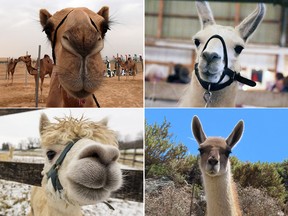‘Even in the most extreme climatic conditions, they produce milk, meat, fibre and organic fertilizer, and provide transport, boosting food security, nutrition, and livelihoods’
Article content
Eddie the alpaca was brought to The Llama Sanctuary in Tappen, British Columbia, while trapped under layers of his overgrown fleece coat.
First thought to be a llama, this Suri alpaca was underweight, unable to properly move, and covered with mites on his face. The alpaca owner had passed away, and the family contacted the sanctuary for help. The sanctuary, which provides emergency care for abandoned llamas and alpacas, shaved thirty pounds of urine- and feces-soaked fleece from his body and worked to rehabilitate Eddie.
Advertisement 2
Article content
Article content
Llamas and alpacas may typically be thought to live in climates different to Canada, but there is a deceiving population nationally. The animals were introduced in the 1980s and ‘90s, and there are approximately 6,000 llamas in the country, according to Llama Canada. As of 2020, there were about 28,500 alpacas , according to the Canadian Llama and Alpaca Association.
There are even more camelids — camels, alpacas, llamas, vicuñas and guanacos — worldwide, and their populations are expected to grow.
These animals are integral in many communities, for cultural and religious significance, as well as for their dependability.
The United Nation’s Food and Agriculture Organization (FAO) has declared 2024 the year of the camelid, for the role they play in terms of food security, one of the 17 Sustainable Development Goals identified by the UN. Sustainability is essential for environmental preservation. Such aims are highlighted on Earth Day, which falls on April 22.
“Even in the most extreme climatic conditions, they produce milk, meat, fibre and organic fertilizer, and provide transport, boosting food security, nutrition, and livelihoods while helping to conserve fragile ecosystems,” said FAO Director-General QU Dongyu at a launch event.
Article content
Advertisement 3
Article content
Camel milk is a global interest that’s only increasing in popularity. It has been a growing phenomenon in parts of the world with hotter, dryer climates for some time. This is due to camels’ ability to sustain drought temperatures and produce more milk on average than cows.
Piers Simpkin is a Global Livestock Advisor for Mercy Corp, who has kept camels for about thirty years outside of Nairobi, Kenya.
“They’re remarkable animals, everything about them – there’s a reason for it,” said Simpkin. He added that they survive in environments cattle can’t and humans struggle to.
They can go ten days without water, where cattle can only go two or three. This means they don’t gather around water sources like cattle do and decimate the grass there, making them easier on the land too, he added.
“With droughts getting more frequent, the cattle are dying out, people are getting poorer … and people sort of recognize now the importance of the camel as a drought resistant animal,” said Simpkin.
Camels aren’t necessarily a fail-safe resource, though. There are challenges to farming with them.
Advertisement 4
Article content
Milking camels takes skill compared to milking cattle. Camel dairy farms also struggle to keep up quantity, as camels have a longer gestation period than cattle, so you have less animals producing milk at a time. A challenge Simpkin has seen is people over-milking their camels, trying to produce enough to stay afloat, and getting fewer calves, as a result. “So, you’ve got sort of this negative selection going on.”
Camel milk has a speciality market. Simpkin often sees interest for its presumed nutritional benefits.
Camel meat is also an industry some rely on for survival. Though the practicalities of setting up a camel meat farm aren’t as good as milk, since camels have so few calves, Simpkin said.
Despite the challenges, the global population of camels has doubled in the last ten years.
Alpacas are also part of the sustainability plan.
While alpacas don’t produce enough milk to be part of dairy farms like camels, their fleece has benefits.
“They’ve been raised for thousands of years to have a nice, lightweight, warm but very breathable fibre … their fleece can regulate their body temperature, and it can do the same for us,” said Kristi Mercier, owner of Harmony Meadows Alpaca, a farm in Belwood, Ont.
Advertisement 5
Article content
Once a year, their alpacas are shaved, and the fibre is sent to mills that spin it into yarn. Not all fiber shaved from an alpaca is usable to take to a mill, sometimes only half of it can be used.
Mercier’s farm has collaborated with a local sheep farm to blend sheep wool and alpaca and make then into fibre pellets. “Which is an amazing alternative to peat moss for planting,” said Mercier. It increases the water retention of the soil and is a slow-release fertilizer. “It means that we’re now able to use 100 per cent of the fibre that we shave off of the animal.”
Camelids are also soft footed animals, that don’t damage the soil. “Horses will rip up a paddock in no time at all,” said David Chapman, one of the owners of The Llama Sanctuary. “Llamas actually nurture the grass.”
Recommended from Editorial
Article content









